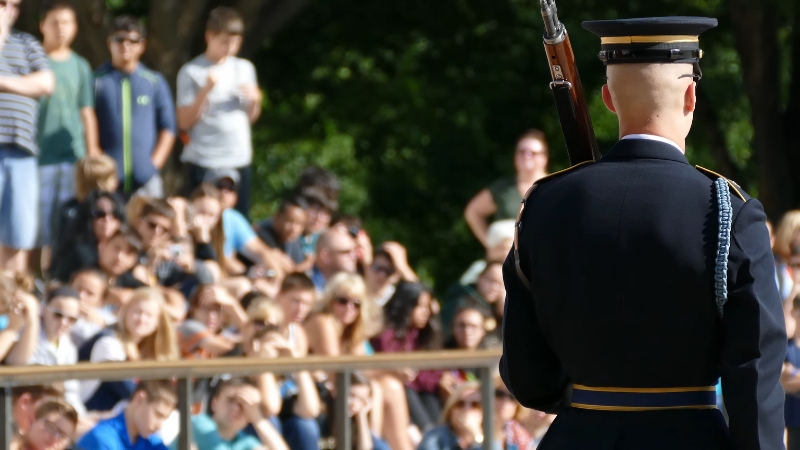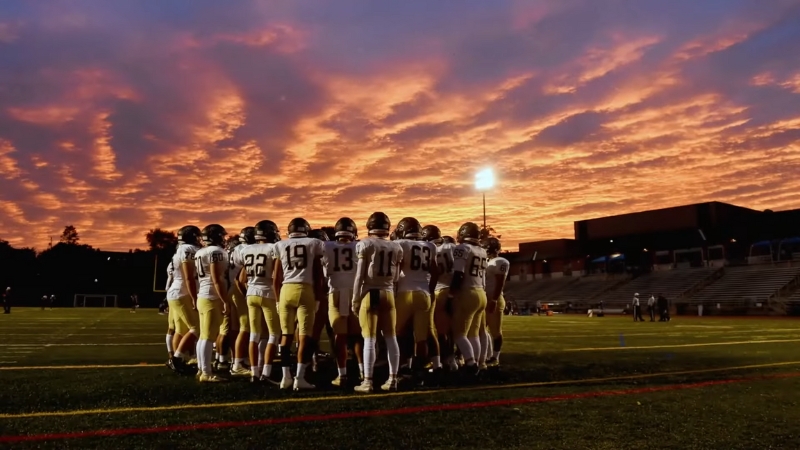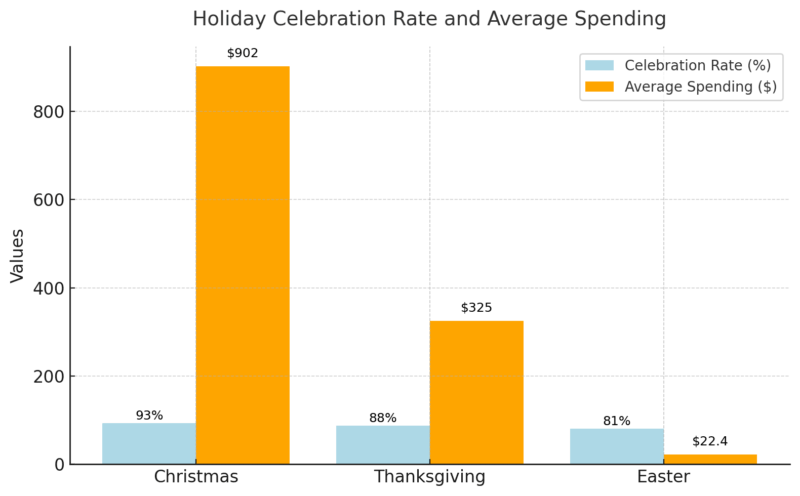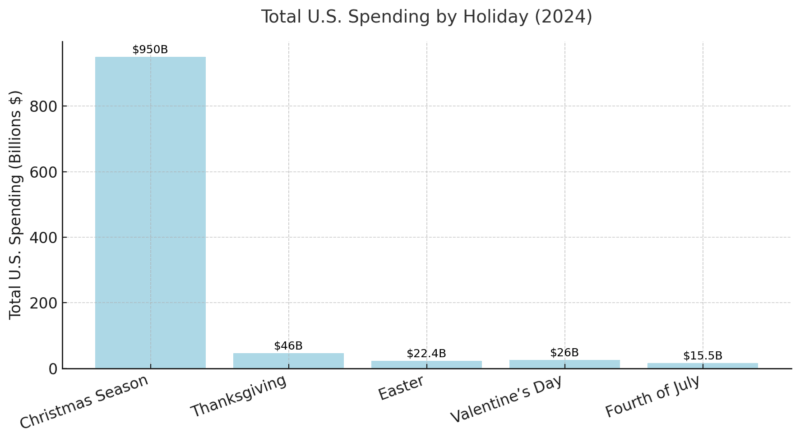For all the diversity of its people and regions, America still comes together in a few unmistakable ways each year, often around the dinner table, under twinkling lights, or in front of a glowing TV.
According to the latest national survey, Christmas and Thanksgiving remain the country’s two most beloved holidays, far ahead of all others.
Americans love holidays that blend tradition, food, family, and emotional familiarity, even when they mean different things to different generations.
Table of Contents
ToggleAmerica’s Favorite Holidays
Rank
Holiday
% Who Calls It Favorite
Core Themes
Average Spending / Participation
1
Christmas
36%
Family, giving, nostalgia
$950B+ total holiday season spend
2
Thanksgiving
23%
Gratitude, food, togetherness
$325 per household avg.
3
Halloween
15%
Imagination, play, fear
$12.2B (2024 record)
4
Easter
13%
Renewal, tradition, spring
$22B+ (NRF)
5
Mother’s Day
13%
Love, appreciation
$34B
6
New Year’s Eve
12%
Hope, reflection
$90B+ travel/hospitality
7
New Year’s Day
12%
Renewal, rest, new goals
–
8
Fourth of July
12%
Patriotism, community, summer
$15.5B
9
Valentine’s Day
8%
Romance, affection
$26B (2025 est.)
10
Father’s Day
8%
Respect, gratitude
$22B
11
Memorial Day
7%
Honor, remembrance
$36B travel/food
12
Super Bowl Sunday
6%
Unity, sports, indulgence
110M viewers; 1.25B wings eaten
13
Veterans Day
6%
Service, patriotism
–
14
Labor Day
5%
Workers’ rights, leisure
$9.2B
15
MLK Jr. Day
4%
Equality, service
Volunteer participation 30%+ growth
16
Juneteenth
4%
Freedom, Black heritage
$1.6B+ events & products
17
Presidents’ Day
3%
History, leadership
$22B retail sales (cars/furniture)
18
Indigenous Peoples’ Day / Columbus Day
3%
Heritage, reflection
Observed in 28 states
19
Earth Day
3%
Environment, sustainability
1B global participants
20
Election Day
3%
Democracy, duty
159M voters (2020 ref.)
21
St. Patrick’s Day
3%
Heritage, celebration
$7.2B (NRF 2024)
1. Christmas – The Unshakable Centerpiece of the American Calendar
Nearly 36 percent of Americans identify Christmas as their favorite holiday, far ahead of every other celebration. It remains the most celebrated holiday in the country and the defining event of the Christian holidays.
More than 93 percent of Americans take part in some form of Christmas tradition, from church attendance to family gatherings, according to Gallup.
When I was younger, Christmas didn’t feel like a religious day so much as a checkpoint, a pause in the year when everyone collectively stepped away from routine. That pause still matters.
Every December, people adjust their pace in unison, and that shared slowdown is one of the few things that unite the country across income, religion, and region.
According to the National Retail Federation, holiday season spending reached $994 billion in 2024, with gifts, travel, and food as the top expenses. Despite the numbers, surveys repeatedly show that satisfaction doesn’t correlate with spending.
The attachment comes from repetition, decorating, cooking, exchanging gifts, and ending the year in familiar company.
2. Thanksgiving – Gratitude and Familiar Faces
Thanksgiving follows close behind as the most popular holiday for 23 percent of Americans. With 290 million people celebrating in 2024 and an average spend of $325 per household, it ranks among the top 20 most celebrated holidays worldwide for both participation and recognition.
In my twenties, I spent one Thanksgiving with friends who couldn’t afford flights home. We shared a roast chicken instead of turkey, and it still felt whole.
That moment showed me what drives this holiday’s endurance: not menu or setting, but inclusion. It’s the one American celebration that doesn’t require faith, gifts, or formality, just presence.
NRF data show consistent spending patterns year after year, but more than half of respondents say what they value most is “time with family.” That explains why Thanksgiving remains one of the most celebrated holidays in the world. Its simplicity makes it universal.
3. Halloween – America’s Most Profitable Secular Holiday

About 15 percent of Americans call Halloween their favorite holiday, according to Lifeway Research. Participation crosses age groups, and spending continues to rise, over $12.2 billion in 2024, the highest on record.
I’ve noticed how Halloween functions as a kind of cultural release valve. It’s one of the few days when people of all ages participate equally, neighborhoods light up, offices host costume contests, and even small towns invest in decorations.
It has become both a social event and an economic engine, with the candy industry alone generating billions during October.
Its success shows how nonreligious celebrations can rival the most established Christian holidays. Halloween ranks consistently among the most celebrated holidays in the U.S. because it combines creativity, nostalgia, and community participation at scale.
4. Easter – Tradition, Continuity, and Renewal
Easter, with 13 percent of Americans choosing it as their favorite holiday, remains a cornerstone of Christian observance and one of the most stable traditions in American households.
I still remember the smell of egg dye on the kitchen table, vinegar, paper towels, and pastel stains. Those sensory details are part of Easter’s staying power: it connects adults to their own childhood experiences through the same small rituals.
In 2024, Easter spending reached $22.4 billion, covering food, gifts, and clothing, according to NRF. Its participation rate is over 80 percent, making it one of the most celebrated Christian holidays after Christmas.
For many, it marks renewal in both a spiritual and seasonal sense, an uncomplicated moment of continuity that blends faith and family.
5. Mother’s Day and Father’s Day – Personal Recognition in a Digital Era
Between 8 and 13 percent of Americans list Mother’s Day or Father’s Day as their favorite holiday. These celebrations are modest but deeply personal. $34 billion was spent on Mother’s Day gifts in 2024, a record high, while Father’s Day saw $22 billion in total spending.
I’ve realized over the years that these days work because they’re short and focused. A single phone call or message often carries more meaning than any material gift.
For many families separated by distance, digital communication has replaced breakfast in bed, but the recognition remains intact.
6. New Year’s Eve and New Year’s Day – America’s Two-Part Reset
Roughly 12 percent of Americans rank New Year’s Eve or New Year’s Day among their favorite holidays. Both are recognized as global observances and among the most celebrated holidays in the world.
Data from the travel and hospitality sectors show record spending during New Year’s week, driven by domestic trips and entertainment events. What defines this period isn’t extravagance but synchronization; everyone marks the same threshold.
I see this as the closest thing modern life has to a collective reflection point: one event that feels equally significant whether you’re in New York, Denver, or abroad.
7. The Fourth of July – A National Symbol of Shared Identity
Independence Day ranks high among the most popular holidays at 12 percent, celebrated by nearly the entire U.S. population. In 2024, spending totaled $15.5 billion, including $9.4 billion on food and $2.2 billion on fireworks, according to the NRF.
I’ve attended many community events over the years, and the most striking thing is how predictable they are: local parades, cookouts, fireworks, and no one seems tired of them.
The Fourth of July functions as a national identity exercise: a reminder that participation itself is the point.
8. Valentine’s Day – Enduring Through Commerce
Despite its commercial nature, 8 percent of Americans call Valentine’s Day their favorite holiday. Spending topped $26 billion in 2025, and over 50 percent of adults planned to participate.
A few years ago, while sorting old papers, I found a childhood Valentine card, a flimsy cartoon rectangle that said “You’re cool.” It reminded me how small gestures, not expensive gifts, sustain this holiday.
Data support that idea: survey respondents cite “simple acts of love” as more meaningful than spending.
9. Memorial Day and Labor Day – The Seasonal Bookends

Memorial Day (7 percent) and Labor Day (5 percent) frame summer and remain among the top 20 most celebrated holidays ranked in national participation. Memorial Day blends remembrance with recreation, while Labor Day recognizes the workforce’s contribution.
Economic impact is strong: combined spending on travel and food exceeds $45 billion annually. These holidays show how Americans attach meaning to the calendar; beginnings and endings matter as much as events themselves.
10. Civic and Emerging Holidays – The Expanding Layer
Holidays like Martin Luther King Jr. Day, Juneteenth, and Indigenous Peoples’ Day register 3–4 percent in national preference surveys. Their participation is smaller, but their cultural importance is increasing.
In my work with younger professionals, I’ve noticed these observances prompt genuine discussion; people share stories about service, heritage, or equality.
Juneteenth awareness reached 90 percent in 2024, and MLK Day volunteerism has risen by 30 percent since 2019. They represent a shift toward values-based holidays rather than leisure-based ones.
11. Super Bowl Sunday – The Modern Secular Feast

Although not a federal holiday, Super Bowl Sunday appears on nearly every list of the most celebrated holidays in the United States. About 6 percent of respondents name it as a favorite holiday.
In 2024, viewership exceeded 110 million people, and U.S. food consumption surpassed 1.25 billion chicken wings on game day.
For years, I’ve watched how workplaces and schools adapt around this event, early closings, Monday fatigue, and shared snacks. It’s proof that shared attention can create a cultural ritual as strong as any religious or civic observance.
What These Holidays Reveal About America
The data show that Christmas and Thanksgiving are the most celebrated holidays in the United States. They consistently rank at the top of surveys on favorite holidays and most popular holidays, combining broad participation with strong emotional attachment.
Across all categories, Christian holidays, civic observances, and secular celebrations, the same principle applies: holidays that involve family and shared time rank higher than those defined only by spending.
Holidays as Emotional Anchors
According to YouGov and the National Retail Federation (NRF), Christmas remains the most popular holiday in the country, followed by Thanksgiving. About 93 percent of Americans celebrate Christmas, and 88 percent observe Thanksgiving.
The average American spends around $902 during the December holiday period, while Thanksgiving averages $325 per household for food and travel, according to the ABC. These figures indicate that major Christian holidays continue to drive both participation and consumer activity in the United States.

Even among nonreligious respondents, these holidays are marked by high participation rates. I find this consistent with my own observation: when people talk about their favorite holiday, they usually mention Christmas or Thanksgiving first, regardless of their faith background.
The Rise of Secular Rituals
The next tier of the most celebrated holidays includes Halloween, Valentine’s Day, and Super Bowl Sunday. These are not religious observances but rank high in national participation. Halloween saw $12.2 billion in U.S. spending in 2024, the highest on record.
Over 110 million Americans watched the 2024 Super Bowl, consuming an estimated 1.25 billion chicken wings. Valentine’s Day spending surpassed $26 billion, with about half of adults participating.
Holiday
Participation
Economic Value
Type
Halloween
74 %
$12.2 B (2024)
Secular
Super Bowl Sunday
110 M viewers
$17 B food/beverage sales
Secular
Valentine’s Day
53 %
$26 B (2025 est.)
Secular
These figures show that the most popular holidays are not limited to religious observance. Cultural events and entertainment-based gatherings now rival traditional holidays in scope and spending.
In my experience, this shift is visible in every community: people plan for the Super Bowl and Halloween as seriously as they plan for Easter.
Civic and Reflective Holidays
Holidays that highlight civic reflection, such as Juneteenth, Martin Luther King Jr. Day, and Indigenous Peoples’ Day, have seen measurable growth in participation.
Awareness of Juneteenth reached 90 percent in 2024 ( up from 74 percent in 2022 ). Volunteer engagement on MLK Day increased by 30 percent compared to 2019.
Holiday
Awareness (2024)
Economic Impact
Notes
Juneteenth
90 %
$1.6 B+ estimated activity
Federal holiday since 2021
MLK Day
86 %
–
Growth in service participation
Indigenous Peoples’ Day
28 states observe
–
Replacing Columbus Day in many regions
Younger adults (18 to 34 years) report greater attachment to these civic holidays. That matches what I notice personally, people under 35 are more likely to mention MLK Day or Juneteenth when asked what is the best holiday in terms of meaning, not leisure.
Spending vs. Sentiment
While retail numbers dominate coverage, the correlation between spending and celebration is not absolute. The average U.S. household spends roughly $1,500 per year across all holidays.
However, the most celebrated holidays remain those centered on family and community rather than high-value purchases.

From my analysis, consumer data confirm that money amplifies participation but doesn’t define affection. For instance, Memorial Day, with limited spending data, still ranks among the top ten favorite holidays due to its national character and seasonal timing.
The Role of Repetition and Seasonal Rhythm
Survey data show that 61 percent of Americans prefer holidays that “feel the same each year.” The calendar structure, winter (Christmas, New Year), spring (Easter), summer (Fourth of July), fall (Thanksgiving, Halloween), organizes both economic and social life.
These repeating events sustain the economy through predictable retail cycles and define family schedules.
As someone who reviews economic data for multiple years, the same pattern appears annually: spending spikes align directly with these holiday clusters. The economic stability they generate mirrors cultural continuity.
Conclusion

If you look closely at the numbers, what defines America’s most celebrated holidays isn’t marketing or religion alone, it’s rhythm.
These dates divide the year into predictable emotional intervals: reflection, gratitude, renewal, indulgence, and rest. They are how a busy country keeps time.
Data from the National Retail Federation and YouGov confirm that holidays with consistent repetition, Christmas, Thanksgiving, and the Fourth of July, create the deepest sense of belonging.
Even secular events like Halloween or the Super Bowl follow this pattern: the same foods, same social habits, same community rituals. People find meaning in reliability, not novelty.
From my own perspective, covering and living through these patterns for years, I’ve come to see holidays as a kind of civic infrastructure. They’re checkpoints that keep people grounded, regardless of politics or belief.
Every celebration, whether it’s fireworks, parades, a Sunday meal, or a few hours in front of the TV, anchors one fact about the United States: despite constant motion, people still seek predictable moments of togetherness.
Related Posts:
- America Is Moving North Again — Here’s Why the…
- Zero-Interest or Subsidized Home Renovation Loans…
- The Rise of Online Nursing Programs - Are They the…
- Average Non-HDL Cholesterol Levels - What They Tell…
- Who Pays the Most Taxes in America? Breakdown by…
- Texas SB3 Breakdown - What the Bill Proposed, Why It…







